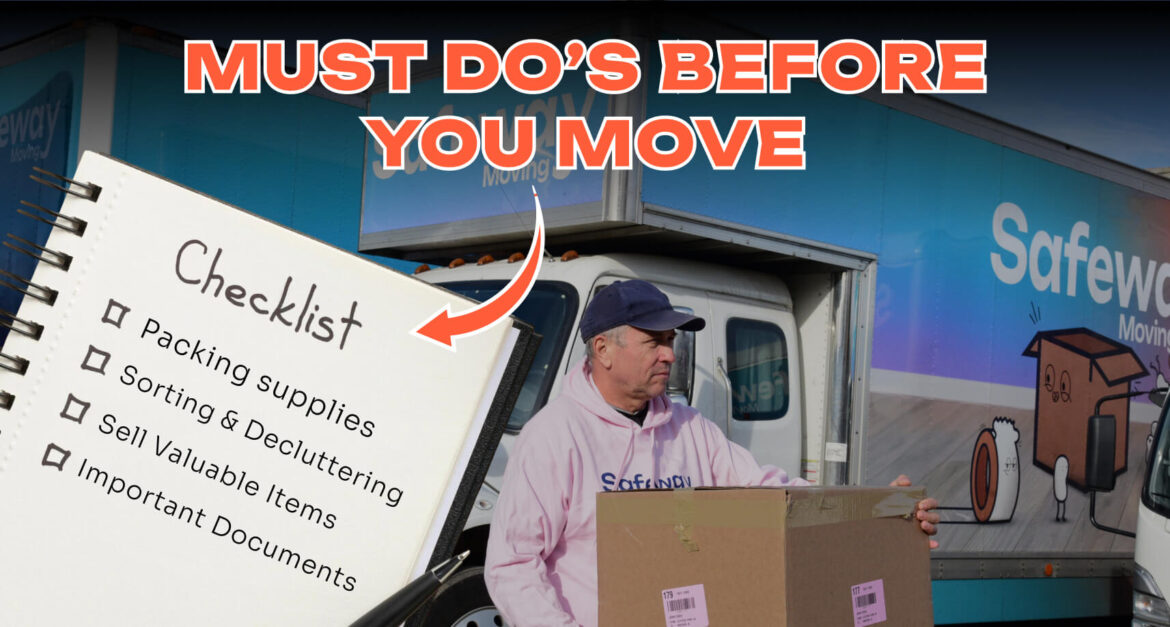
Moving to a new home or office is an exciting yet overwhelming process. Whether you are moving across town or to a different state, proper planning is essential to ensure a smooth transition. A well-organized packing and moving checklist can make all the difference in reducing stress and preventing last-minute chaos. This guide will help you stay on top of everything, from gathering supplies to settling into your new space. With a systematic approach, you can ensure that your belongings are packed safely and transported without hassle.
Don’t know where to start? Check our moving checklist before you move.
Why You Need a Packing and Moving Checklist
A packing and moving checklist is not just a convenience; it is a necessity for a seamless move. Without a structured plan, you may find yourself scrambling to pack items at the last minute or forgetting essential belongings. Having a checklist ensures that every step of the process is accounted for and helps avoid unnecessary stress.
Moreover, a checklist allows you to distribute tasks efficiently, especially if you have family members or professional movers assisting you. It also provides a clear timeline, helping you stay organized throughout the moving process. Additionally, using a checklist helps prevent damage to valuable items, as you can plan and pack them properly.
Some key benefits of a packing and moving checklist include:
- Efficient Organization: Keeps you on track and prevents important tasks from being overlooked.
- Time Management: Helps in allocating time effectively for different moving tasks.
- Reduced Stress: Eliminates last-minute rushing and enhances a smooth moving experience.
- Proper Packing: Ensures fragile items are handled with care and packed securely.
- Cost Efficiency: Helps in budgeting for moving supplies and services without unnecessary expenses.
Gathering Packing Supplies: The First Step to an Organized Move
Before you start packing, having the right supplies is crucial. Many people underestimate the number of materials needed, leading to frequent trips to the store. To avoid this hassle, make a list of essential packing supplies in advance and ensure you have them ready before you begin packing.
The essential packing materials include:
- Sturdy Moving Boxes: Available in different sizes, these protect your belongings during transit.
- Packing Tape: Strong tape is necessary to secure boxes and prevent them from opening.
- Bubble Wrap and Packing Paper: These protect fragile items from damage during transportation.
- Labels and Markers: Clear labeling makes unpacking much easier and ensures boxes end up in the right rooms.
- Furniture Covers and Stretch Wrap: These protect large furniture pieces from dust and scratches.
- Scissors and Box Cutters: Essential for opening and securing boxes efficiently.
- Ziploc Bags: Great for storing small items like screws and bolts when dismantling furniture.
Sorting and Decluttering: Reducing the Load Before the Move
One of the most crucial steps before packing is decluttering. Moving presents a great opportunity to eliminate unnecessary items and lighten your load. The less you have to pack, the easier and cheaper your move will be. Decluttering also ensures that your new home is free from clutter, allowing for a fresh start.
To declutter effectively, follow these steps:
- Sort Your Items by Category: Go through each room and categorize items into “Keep,” “Donate,” “Sell,” and “Dispose.”
- Assess the Usefulness of Each Item: If you haven’t used something in over a year, consider letting it go.
- Donate Unwanted Items: Many charitable organizations accept gently used clothing, furniture, and electronics.
- Sell Valuable Items: You can list items on online marketplaces or hold a garage sale to earn extra cash.
- Dispose of Unusable Items Properly: Recycle or discard broken or expired items responsibly.
By downsizing before your move, you save time, effort, and moving costs while creating a more organized and clutter-free home.
Efficient Packing Strategies: Protecting Your Belongings
Packing efficiently can make a significant difference in how smooth your move goes. Poor packing can lead to broken items, disorganization, and increased moving time. Following a strategic approach will ensure that everything is packed securely and unpacking becomes easier.
1. Packing Tips for Maximum Efficiency
- Start Packing Early: Begin with non-essential items several weeks before moving day.
- Pack Room by Room: Label each box with the room it belongs to for an easy unpacking process.
- Use the Right Box Size: Heavy items should go in small boxes, while lighter items can go in larger ones.
- Wrap Fragile Items Properly: Use bubble wrap and packing paper for breakable objects.
- Fill Empty Spaces in Boxes: Use towels, blankets, or packing paper to prevent items from shifting.
- Keep Important Documents Separate: Store passports, medical records, and financial papers in a personal bag.
- Pack an Essentials Box: Include toiletries, snacks, chargers, and a change of clothes for easy access on moving day.
If you want expert packing services, Safeway Moving provides professional assistance to ensure your belongings are packed safely and securely.
Final Moving Day Checklist: Ensuring a Smooth Transition
Moving day can be hectic, but a detailed checklist will keep everything in order. A structured plan will help you avoid forgetting essential tasks and make the transition seamless.
1. Moving Day Essentials
- Confirm Moving Details: Double-check the time and address with your moving company.
- Do a Final Walkthrough: Ensure nothing is left behind in closets, cabinets, or storage spaces.
- Supervise the Loading Process: Guide the movers on handling fragile items and special belongings.
- Take Photos of Your Old Home: This is useful for rental agreements and documentation.
- Check Utilities at the New Home: Make sure electricity, water, and internet are set up before arrival.
- Unpack the Essentials First: Focus on setting up bedrooms and the kitchen to settle in comfortably.
With proper planning and a structured approach, moving day can be smooth and stress-free.
It is recommended to start packing at least 4–6 weeks before your moving date. Begin with non-essential items and gradually move to daily-use items as moving day approaches.
Start by packing seasonal and rarely used items such as holiday decorations, books, and out-of-season clothes. Then move on to kitchenware, linens, and finally, daily essentials.
Label each box clearly with its contents and designated room. Unpack one room at a time, starting with essentials like the bedroom and kitchen. Keeping a detailed inventory also helps.










